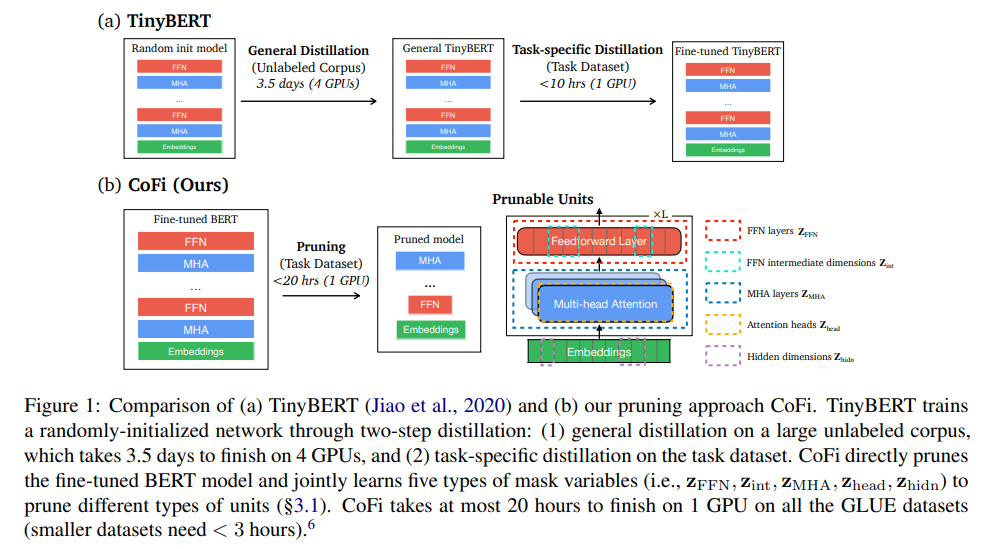
Structured Pruning Learns Compact and Accurate Models
LLM Propose a task-specific structured pruning method CoFi1 (Coarse- and Fine-grained Pruning), which delivers highly parallelizable subnetworks and matches the distillation methods in both accuracy and latency, without resorting to any unlabeled data.
1 Background:
The growing size of neural language models has led to increased attention in model compression. The two predominant approaches are pruning, which gradually removes weights from a pre-trained model, and distillation, which trains a smaller compact model to match a larger one
Multi-head attention \[\operatorname{MHA}(X)=\sum_{i=1}^{N_h} \mathbf{z}_{\text {head }}^{(i)} \operatorname{Att}\left(W_Q^{(i)}, W_K^{(i)}, W_V^{(i)}, W_O^{(i)}, X\right)\]
Feed-forward layer \[\operatorname{FFN}(X)=\operatorname{gelu}\left(X W_U\right) \cdot \operatorname{diag}\left(\mathbf{z}_{\text {int }}\right) \cdot W_D\]
2 Related work:
Pre-trained language models have high costs in terms of storage, memory, and computation time and it has motivated a large body of work on model compression to make them smaller and faster to use in real-world applications
3 Challenges:
Pruning methods can significantly reduce the model size but hardly achieve large speedups as distillation. However, distillation methods require large amounts of unlabeled data and are expensive to train.
4 Motivation:
Propose a task-specific structured pruning method CoFi1 (Coarse- and Fine-grained Pruning), which delivers highly parallelizable subnetworks and matches the distillation methods in both accuracy and latency, without resorting to any unlabeled data

5 Proposed Methods:
Pruning Methods
- Layer pruning 50% 2x
- Head pruning 1.4x
- FFN pruning
- Block and unstructured pruning

Method
Coarse- and Fine-Grained Pruning
- present a simple solution: we allow pruning MHA and FFN layers explicitly along with fine-grained units
- Explicitly prune an entire layer, instead of pruning all the heads in one MHA layer
Pruning the output dimensions of $MHA(X)$ and $FFN(X)$, referred to as ‘hidden dimensions’ in this paper.
- Find that only a small number of dimensions are pruned (e.g., 768 → 760), but it still helps improve performance significantly
- Multiple mask variables jointly control the pruning decision of one single parameter.
- Replace the vanilla $l_0$ objective with a Lagrangian multiplier to better control the desired sparsity of pruned models.
Distillation to Pruned Model
A cross-entropy loss between the pruned student’s and the teacher’s output probability: \[\mathcal{L}_{\text {pred }}=D_{\mathrm{KL}}\left(\mathbf{p}_s \| \mathbf{p}_t\right)\]
- Propose a layerwise distillation approach for pruning to best utilize the signals from the teacher model.
- Dynamically search a layer mapping between the full teacher model and the pruned student model.
- The layer mapping function $m(·)$ is dynamically determined during the training process to match a teacher layer to its closest layer in the student model
- To address the issue of layer mismatch, which mostly happens for small-sized datasets, e.g., RTE, MRPC, we add a constraint to only allow matching a teacher layer to a lower student layer than the previously matched student layer.
6 Evaluation:
Env: single NVIDIA V100 GPU (32G mem)


For TinyBERT and DynaBERT, the released models are trained with task-specific augmented. 
7 Results:
CoFi delivers more accurate models than distillation and pruning baselines at every speedup level and model size.
While general distillation could take up to hundreds of GPU hours for training, CoFi trains for a maximum of 20 hours on a taskspecific dataset with a single GPU.
Pruning units
 Removing the option to prune hidden dimensions ($z_{hidn}$) leads to a slightly faster model with a performance drop across the board and we find that it removes more layers than CoFi and does not lead to optimal performance under a specific sparsity constraint.
Removing the option to prune hidden dimensions ($z_{hidn}$) leads to a slightly faster model with a performance drop across the board and we find that it removes more layers than CoFi and does not lead to optimal performance under a specific sparsity constraint.
Removing the layer masks ($z_{MHA}, z_{FFN}$) brings a significant drop in speedup on highly compressed models (95%, 5M).
This result shows that even with the same amount of parameters, different configurations for a model could lead to drastically different speedups.However, it does not affect the lower sparsity regime (60%, 34M).
Distillation objectives
Removing distillation entirely leads to a performance drop up to 1.9-6.8 points across various datasets, showing the necessity to combine pruning and distillation for maintaining performance 
Interestingly, the proposed dynamic layer matching objective consistently converges to a specific alignment between the layers of the teacher model and student model.
